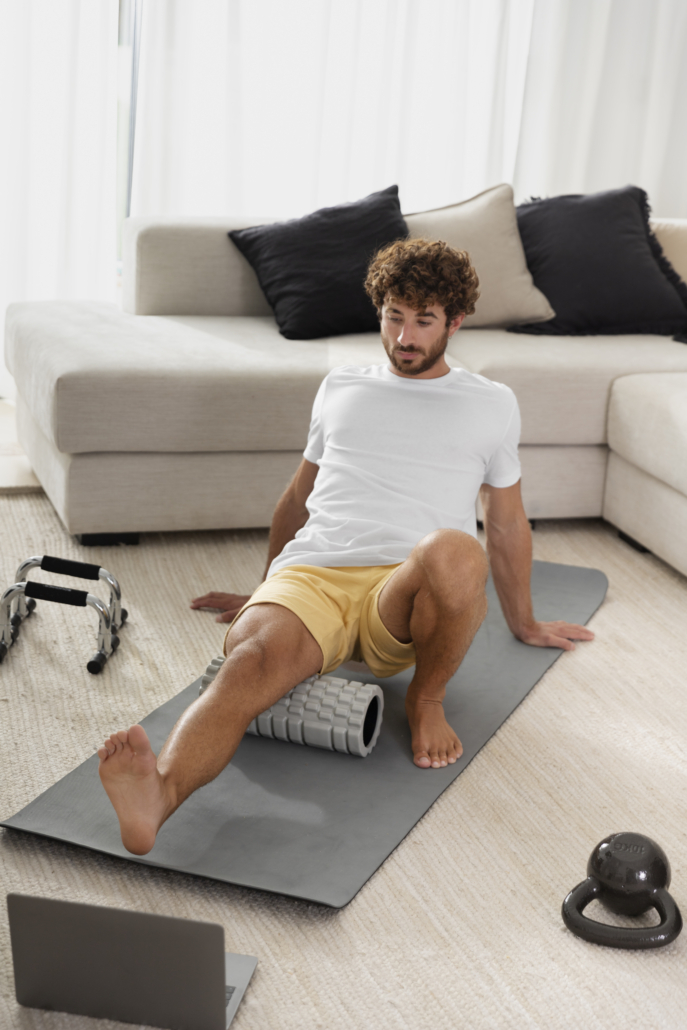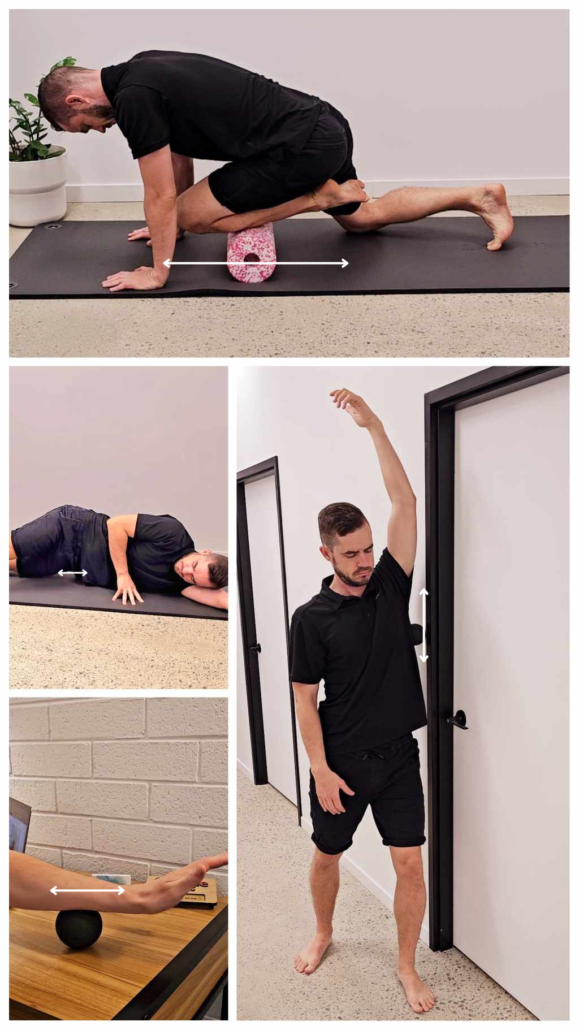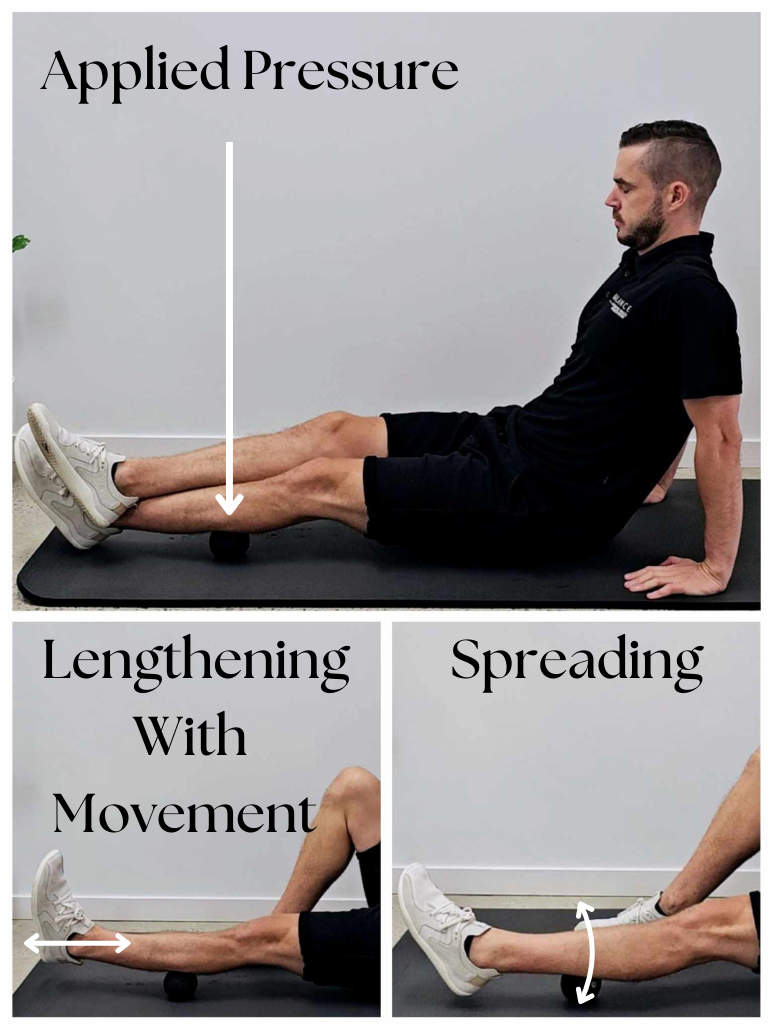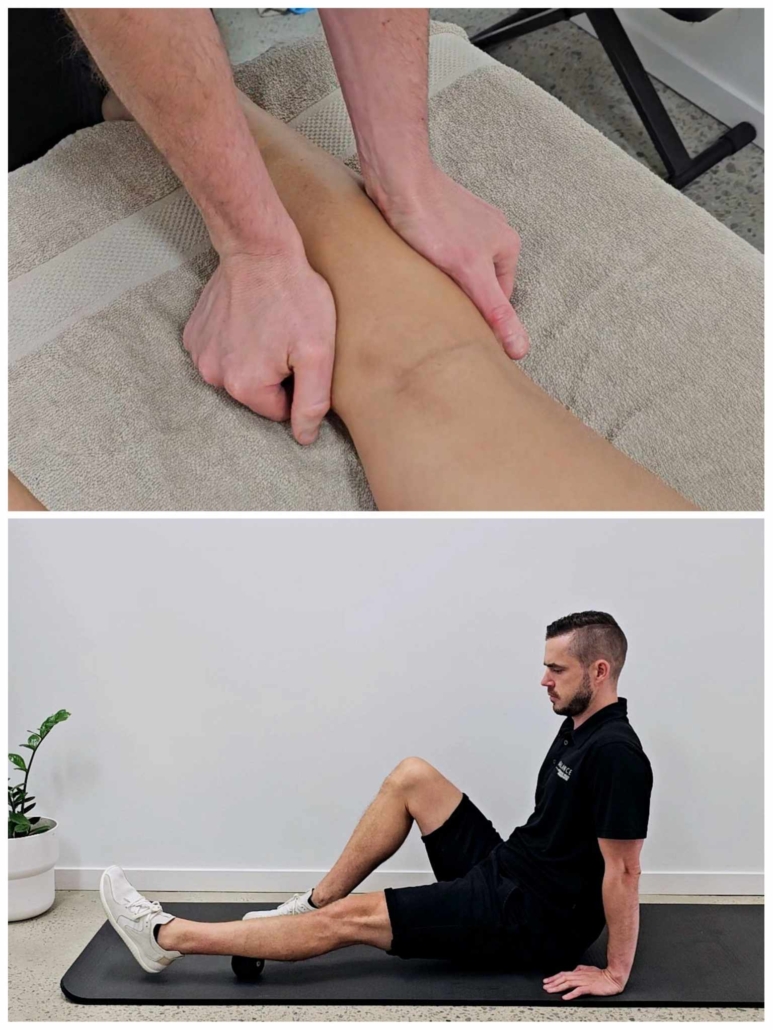How to SMFR
Self-Myofascial Release (SMFR) is a fantastic form of self-treatment and maintenance between bodywork and movement sessions that can help relieve muscle and fascia (myofascia) tension, enhance movement ease, and promote better function in your fascial system as a whole.
Using tools like foam rollers, prickle balls, smooth massage balls, or even your fingers and elbows, SMFR allows you to target specific muscles and apply a variety of techniques to achieve different results:
- Applied Pressure: Great for easing tender spots and relieving tension.
- Lengthening With Movement: Restore joint range and tissue length by lengthening in the direction of muscle fibres or lengthening through joint movement.
- Spreading: Ease myofascial tightness by working across the muscle fibers, broadening tissue, allowing relaxation and improved movement function.
*MyoFascia: Muscle and Fascia – learn more below.
Benefits of SMFR
SMFR provides numerous benefits that not only offer immediate relief but also promote long-term fascial health:
- Improved Body Awareness
SMFR stimulates the sensory nerves embedded in your fascia, helping you connect more deeply with your body. This heightened awareness allows you to identify areas of tightness or imbalance, enabling you to move with greater intention and control. - Enhanced Glide
By improving the ability of fascial layers, muscles, and compartments to slide smoothly over one another, SMFR reduces friction and stiffness. This enhances movement efficiency and reduces strain during physical activity. - Hydration
SMFR helps flush and restore water content in fascial tissues, particularly in areas under constant tension. This rehydration improves tissue pliability, resilience, and overall function, ensuring your fascia stays healthy and adaptable. - Remodeling
Consistent SMFR and movement can lead to adaptive changes in the fascia. Over time, tension in fascia reorganizes collagen fibers, reducing restrictions and improving long-term tissue health and mobility.
Top 5 Areas for SMFR
1. Your Feet
- Start your session by rolling a small ball under your feet or with applied pressure to specific points to release tension and improve balance.
2. The Glutes
- Lengthen your glutes in their fibre direction with a foam roller or massage ball to ease tightness and support hip mobility. For some, this can also help relieve lower back tension.
3. The Lower Back
- Spreading or applied pressure in this area can alleviate tension, just avoid applying direct pressure on the spine.
4. The Upper Back
- Use a foam roller and lengthen in the direction of the upper back muscle fibres, this can help improve posture and mobility. Another tip is to extend your upper back through movement to promote extension, especially if you find you slump through the front of your body
5. Your Neck
- Use prickle balls to spread and lengthen the myofascia of the neck, this can also help in hydrating fascia and easing tension. This area is also great for stress relief and headaches.
What is Myofascia?
Myofascia is the combination of muscle and fascia.
- Muscles are encased in fascia, much like oranges are held in mesh bags.
- The fascia maintains the shape of the muscle, while the muscle maintains the tension within the fascial system.
Although individual myofascial compartments are separated, they are interconnected through the fascial network, forming a continuous system throughout your body. This interconnectedness means tension in one area can transmit throughout the entire fascial system!
SMFR can have therapeutic effects both locally and globally. This may explain why you feel a “release” in areas far from where you’re applying pressure.
Tip: After an SMFR session, go for a short walk to notice the local and global changes in how your body moves and feels.
The 4 Most Overlooked Areas for SMFR
- Your Shins
- Often neglected, easing tension here can benefit knee and ankle mobility.
- Sides of Your Hips
- Targeting the tensor fasciae latae (TFL) and glute medius improves hip stability and alleviates tension in the IT band.
- Under Your Arms
- Addressing tightness in the lats can improve shoulder mobility and reduce strain in the upper back.
- The Forearms
- Perfect for anyone using a keyboard or performing repetitive hand movements.
What is Being Released?
In SMFR, “release” is more of a subjective term than a literal one.
- You might experience an emotional release when working on your abdominal area, while someone else may feel relief from pain or tightness.
- Fascia itself is far too strong to truly “release” in the way some may imagine.
Instead, the benefits of SMFR are likely due to:
- Changes in hydration (restoring water content in the fascia).
- Improved glide (enhancing the sliding of fascial layers).
- Neural signaling (modulating nerve responses to reduce pain and tension).
Rather than physically separating tissues, SMFR promotes better function and resilience in the fascial system.
Time, Technique & Frequency
The effectiveness of Self-Myofascial Release (SMFR) depends on consistency and appropriate timing. Here are some guidelines to help you incorporate SMFR into your routine:
- Frequency: Aim for 3–5 sessions per week for general maintenance. For targeted relief (e.g., after intense exercise or to address chronic tension), daily application may be beneficial.
- Duration: Spend 30–60 seconds per area, gradually increasing pressure as needed. Avoid overworking any single spot to prevent irritation or inflammation.
- Timing:
- Use SMFR after workouts to aid recovery and reduce post-exercise soreness.
- Incorporate SMFR into your evening routine to promote relaxation and unwind from daily stress.
- Listen to Your Body: Adjust frequency and pressure based on how your body feels. SMFR should never be painful; slight discomfort is okay but stay within a tolerable range.
By dedicating just a few minutes a day to SMFR, you can enhance its long-term benefits for your fascial health and overall well-being.
SMFR techniques.
How SMFR Supports Massage & ATSI Bodywork
SMFR is an excellent complement Remedial Massage and Anatomy Trains Structural Integration (ATSI)bodywork sessions. By engaging in regular SMFR, you can:
- Maintain the benefits of your bodywork between sessions.
- Prepare your body for deeper, more effective work during treatments.
- Enhance your awareness of specific areas that need attention, making your sessions more focused and productive.
Maintaining Myofascia between bodywork sessions – spreading in clinic and spreading tissue in SMFR
A Simple Tool For Maintenance & Fascial Health
Self-Myofascial Release (SMFR) is a simple yet powerful tool for improving your body’s function and reducing tension. Whether you’re addressing specific tight spots, improving your overall movement quality, or supporting professional bodywork, SMFR offers accessible benefits for anyone looking to feel and move better.
Take a few minutes a day to incorporate SMFR into your routine, and notice how it transforms your body awareness, mobility, and overall well-being.
Thanks for reading,
Lewis







